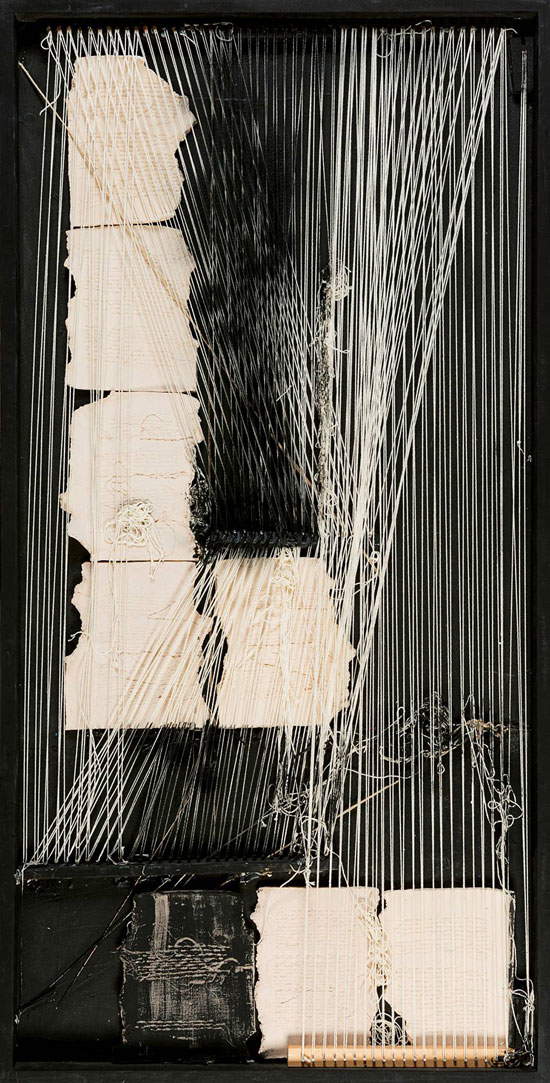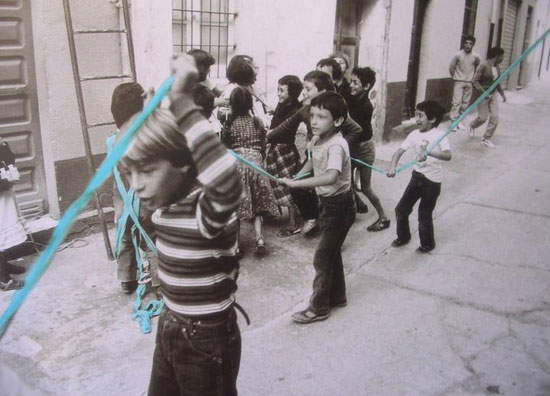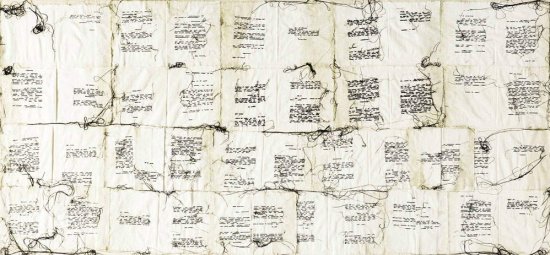Poetic amanuensis of sewing: this is how critic Giorgio Di Genova defines, in his monumental History of 20th-century Italian Art, Maria Lai (1919 - 2013), an unforgettable Sardinian artist capable of “playing” (the term is hers) with embroidery, threads, canvases, boards, wood, acrylic paints and whatever happened to be under her hands to combine everything into always original forms. There is a definite thread that distinguishes Maria Lai’s entire career, and it is a thread in the true sense of the word, because her particular and innovative artistic research found its most intense moments in the interpretation of the ancient art of weaving. Although Maria Lai was born in a small village in the mountains of Ogliastra, Ulàssai, she had moved to the continent to train. She studied in Rome and Venice, and her teachers were some of the most fashionable artists of the 1930s and 1940s: one need only mention the names of Arturo Martini and Marino Mazzacurati. Yet, the call of his native land must have been particularly strong if the artist decided to return to Sardinia soon. Certainly: throughout the span of her existence, Maria Lai achieved international success, exhibiting at the most prestigious exhibitions. But her most congenial dimension was precisely her island.
One could not understand Maria Lai’s art if one left out this deep connection with her homeland, because her work is strongly rooted in tradition. Her contacts with the exponents ofarte povera probably influenced the choice of materials with which Maria Lai made her works: materials far removed from those of the academic tradition, but close to the age-old customs of the inhabitants of her land. Already in the 1940s, during the period of her training, the artist showed a marked sensitivity to the theme of women’s work: hers is a universe made up of women going to the mill, caring for children, and attending to weaving. And weaving became so important to Maria Lai that it distinguished, as mentioned, the most original strand of her artistic research. With her works, Maria Lai reinterpreted an age-old art, made up of constant gestures unchanged for centuries, of painstaking attention, of all-female wisdom. In this article, which stems from a collaboration with the auction house Minerva Auctions (which first introduced the figure of Maria Lai to auction houses), we have chosen three works, executed about twenty years apart, to find three highly significant examples of Maria Lai’s art.
In the 1960s, the artist elevated the loom, the weaving tool, to an art object, creating works in which the weaving machine became the protagonist in ever new forms.The 1964 Progetto per ordito (Project for War p), from a private collection in Cagliari, belongs to the loom series. Thewarp is the set of threads that are attached to the loom, vertically: the weaver, making use of a shuttle that runs horizontally across the loom, will weave the weft, that is, the set of horizontal threads, to the warp in order to create the fabric. In Maria Lai’s art, the loom becomes the support that gives life to her creations: just as the weaving loom gives way for the woman to create textiles now simple, now complex, now sober, now full of color, Maria Lai’s loom accommodates cotton threads arranged according to the artist’s whim, to communicate feelings and sensations. Not only threads, but also elements in the most disparate materials: in this Warp Project we find some in wood arranged almost as if they were pages on which the threads intertwine to tell stories. So much so that the artist has chosen, in this work of his, to reduce the chromatic range to a minimum: we find only the black of the tempera that covers the support, and the natural colors of cotton and wood, which tend toward white.
 |
| Maria Lai, Project for Warp (1964; tempera, terracotta, cotton thread, wood and nails on board, 123 x 62 cm; private collection) |
We will return to the subject of weaving as narrative in a moment: first it is necessary to dwell on what is perhaps Maria Lai’s most famous work, Binding to the Mountain. This is a performance: the artist has always been attentive to all forms of expression, even the newest and most provocative ones, and this work of hers is a full demonstration of that. This is 1981, and the basic idea was, in its theory, very simple, because it involved tying all the houses in Ulassai with a ribbon. A simple idea, but complex because of all the implications it carried. And which was born, as the artist herself recalled, on a very specific occasion: “Away for many years, I was called to Ulassai because they wanted me to make a war memorial. I found myself in a country of shepherds and goats, where I was born, dominated by personal grudges, and I was frightened. Of course I didn’t agree to do the monument and decided to do something for the living, but I didn’t know what.” After Maria Lai thought about it, that “something” she could do for the “living” in her hometown flashed in her mind: she remembered a folk legend, known to all the children in the village, about a little girl who had to bring bread to some shepherds. Assuming her task, she was surprised by a storm, and therefore decided to take refuge in a cave, together with the shepherds, to avoid getting wet in the rain. Suddenly, the little girl saw a celestial ribbon flying in the sky, and decided to follow it: the shepherds did not do the same, because they did not want to expose themselves to the dangers of the storm. Just as the little girl was leaving the cave, the cave collapsed under the force of the storm, sweeping away the shepherds and the flocks inside.
Maria Lai saw the cave as a metaphor for the village and, in general, the contemporary world, and the storm as a symbol of the grudges that divide its inhabitants: hers wanted to be an intervention aimed at demonstrating how art and beauty could point a way to salvation. A thread binding all the inhabitants was to be a symbol of unity against hatred and adversity. It was not easy to overcome mistrust, and many were the material difficulties the artist faced, including hostility from many of his fellow villagers. Fortunately, a collaborative nature eventually prevailed: Maria Lai was able to pass no less than twenty-seven kilometers of celestial ribbon through the homes of her village, and three climbers from Cagliari even managed to carry the ribbon to Mount Gedili: the mountain overlooking Ulassai was thus linked to the village. And the whole thing was documented by an evocative photo report by Piero Berengo Gardin.
 |
| Maria Lai, a moment of the environmental intervention Bound to the Mountain in one of Piero Berengo Gardin’s photographs (1981; photo from the artist’s official website ). |
Stories, legends and traditions are thus evoked through a thread to bring out a message of universal scope. For it has already been anticipated how weaving also plays, in Maria Lai’s art, the role of a suitable medium for storytelling: and this particular vocation of weaving is made explicit in the series of “Books,” to which Renato’s Diary belongs, one of Maria Lai’s most recent works, executed in 2007 and, like the Warp Project, dated and signed. After waiting for the weaving, the women would gather to keep each other company, telling anecdotes and stories to pass the time. In her “Books,” Maria Lai uses a cotton thread that passes through white sheets, made from a sheet in the case of Renato’s Diary, to form word-like marks. The thread then becomes an original ink that fixes that repertoire of tales and legends of tradition, often, however, without the signs left by Maria Lai taking the form of really existing alphabets: the work of Maria Lai, after all, does not aim to provide the viewer with an objective description of the tale, but aims to suggest the atmospheres of the stories. And her suggestive art is thus much closer to poetry than to storytelling.
At the Minerva Auctions headquarters (Palazzo Odescalchi, Piazza SS. Apostoli 80, Rome) it is possible to visit free exhibitions of the works that will be auctioned. Minerva Auctions’ website is www.minervaauctions.com.Theartist’s official website is www.maria-lai.com. |
| Maria Lai, Renato’s Diary (2007; sewn sheet, embroidery and black thread on canvas applied to board, 86.5 x 185 cm; private collection) |
Warning: the translation into English of the original Italian article was created using automatic tools. We undertake to review all articles, but we do not guarantee the total absence of inaccuracies in the translation due to the program. You can find the original by clicking on the ITA button. If you find any mistake,please contact us.